System Overview
The fuel tank stores the fuel supply. An electric fuel pump, located
in the fuel tank with the fuel sender assembly, pumps the fuel through an
in-line fuel filter to the fuel rail assembly. The pump provides
the fuel at a pressure greater than is needed by the injectors.
The fuel pressure regulator, part of the fuel sender assembly, keeps
the fuel available to the injectors at a regulated pressure. A separate
pipe returns the unused fuel to the fuel tank.
Fuel Tank
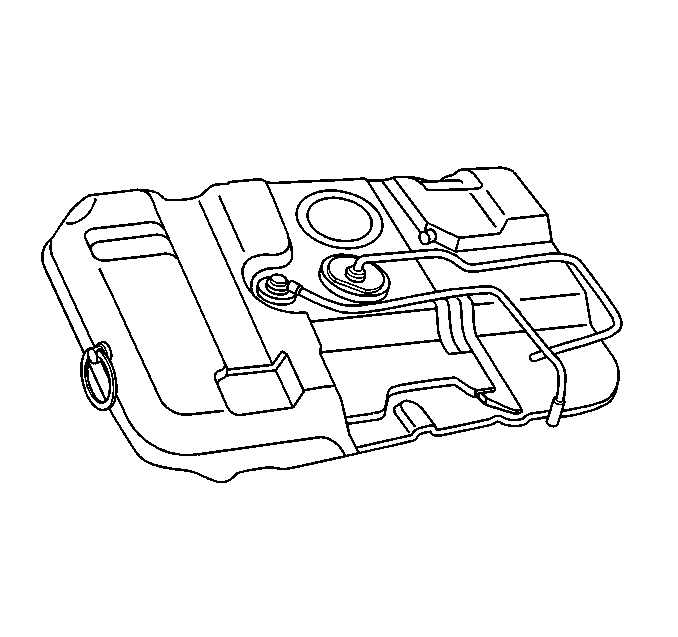
The fuel tank stores the
fuel supply. The fuel tank is located in the rear of the vehicle. The fuel
tank is held in place by 2 metal straps that attach to the frame.
The fuel tank is molded from high density polyethylene.
Fuel Tank Filler Pipe
The fuel tank filler pipe has a built-in restrictor and deflector in
order to prevent refueling with leaded fuel.
Fuel Filler Cap
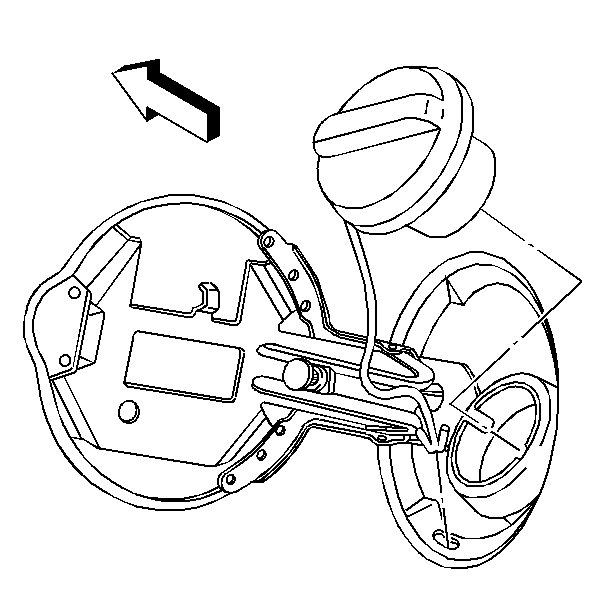
Notice: If a fuel tank filler cap requires replacement, use only a fuel tank
filler cap with the same features. Failure to use the correct fuel tank filler
cap can result in a serious malfunction of the fuel and EVAP system.
The fuel tank filler pipe has a tethered fuel filler cap.
The cap requires a quarter of a turn to be removed. A torque-limiting device
prevents the cap from being over tightened. To install the cap,
turn the cap clockwise until you hear 3 clicks. This indicates
that the cap is correctly torqued and fully seated.
Fuel Sender Assembly
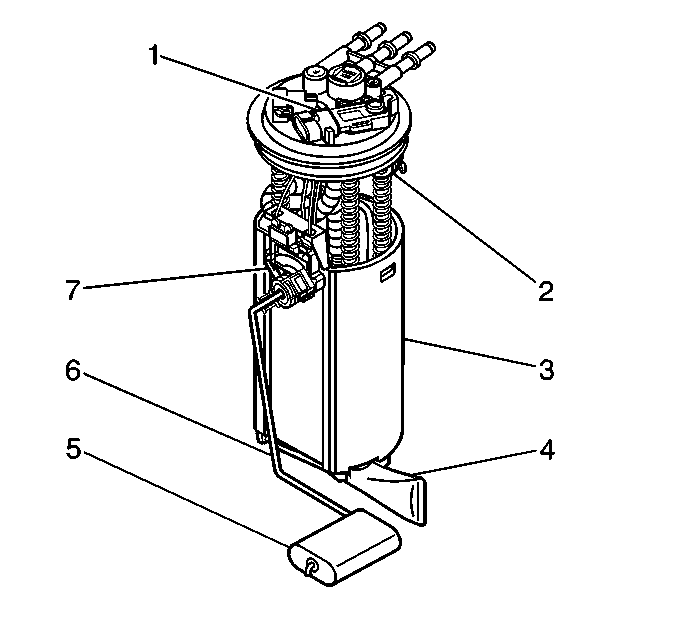
The fuel sender assembly
is inside the fuel tank attached to the top of the fuel tank. The fuel sender
assembly consists of the following major components:
| • | The fuel level sensor (7) |
| • | The fuel tank pressure sensor (1) |
| • | The fuel pump and reservoir assembly (3) |
| • | The fuel pressure regulator (2) |
| • | The fuel pump strainer (4) |
Fuel Sender

The fuel sender consists
of a float (5), a wire float arm (6), and a fuel level sensor (7).
The position of the float arm indicates the fuel level and a signal
is sent to the display in the vehicle instrument cluster. The EVAP
pipe of the fuel sender has a pressed in roll-over valve. The roll-over
valve prevents fuel from entering the evaporative emission canister
if the vehicle rolls over by shutting OFF the EVAP pipe to the canister.
Fuel Pump
The fuel pump is mounted inside the fuel reservoir on the fuel sender.
The fuel pump is an electric high pressure generator pump. The fuel pump
pumps the fuel to the fuel rail assembly at a specified flow and pressure.
Excess fuel returns to the fuel tank by the return pipe. The fuel
pump delivers a constant flow of fuel to the engine even during
low fuel conditions and aggressive vehicle maneuvers. The PCM controls
the electric fuel pump operation through a fuel pump relay. The
fuel pump flex pipe acts to dampen the fuel pulses and the noises
that are generated by the fuel pump.
Fuel Pressure Regulator Assembly
The fuel pressure regulator attaches to the fuel return pipe on the
fuel sender assembly. The fuel pressure regulator is a diaphragm-operated
relief valve. A software bias compensates the injector on-time because
the fuel pressure regulator is not referenced to manifold vacuum.
The injector pulse width varies with the signal from the MAP sensor.
With the ignition ON and the engine OFF, system fuel pressure at
the pressure test connection should be 380-410 kPa
(55-60 psi). If the pressure is too low, poor performance
could result. If the pressure is too high, excessive odor and a
Diagnostic Trouble Code (DTC) P0132, P0152, P0172, or P0175 may
result. Refer to
Fuel System Diagnosis
for
information on diagnosing fuel pressure conditions.
Fuel Pump Strainer
The fuel pump strainer attaches to the lower end of the fuel pump and
reservoir assembly. The fuel pump strainer is made of woven plastic. The
functions of the fuel pump strainer are to filter the contaminants
and to wick the fuel. The fuel pump strainer is self-cleaning and
normally requires no maintenance. Fuel stoppage at this point indicates
that the fuel tank contains an abnormal amount of sediment or water.
Clean the fuel tank and replace a plugged fuel pump strainer with
a new one.
In-Line Fuel Filter
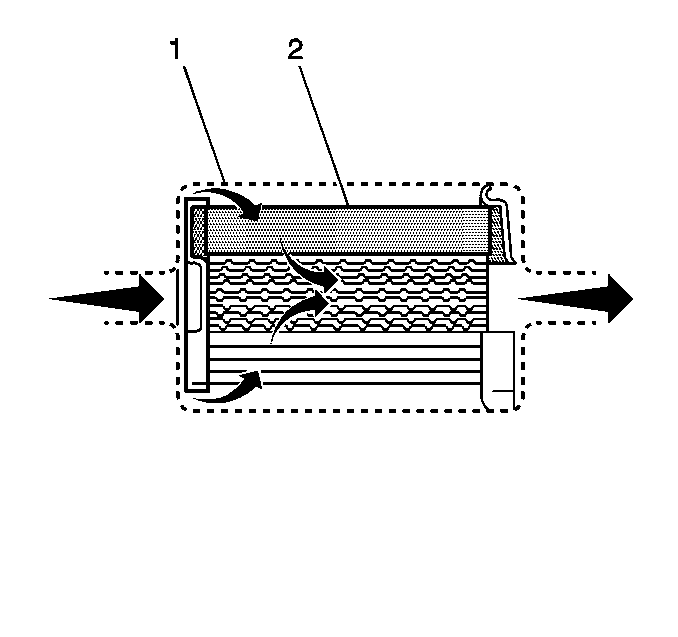
The fuel feed pipe has
a steel fuel filter installed ahead of the fuel injection system. The paper
filter element (2) traps particles in the fuel that may
damage the injection system. The filter housing (1) is made
to withstand maximum fuel system pressure, exposure to fuel additives,
and changes in temperature. The fuel filter has a quick-connect
inlet fitting and a threaded outlet fitting. The threaded fitting
is sealed with an O-ring. There is no service interval for fuel
filter replacement. Replace a restricted fuel filter.
Fuel Feed and Return Pipes
The fuel feed pipe carries the fuel from the fuel tank to the fuel rail
assembly. The fuel return pipe carries fuel from the T-connector, located
on the outlet side of the fuel filter back to the fuel tank. The
fuel pipes consist of 3 sections:
| • | The rear fuel pipe assemblies are located from the top of the
fuel tank to the chassis fuel pipes. The rear fuel pipes are constructed of
nylon. |
| • | The chassis fuel pipes are located under the vehicle. The chassis
fuel feed pipe connects the rear fuel feed pipe to the engine compartment
connecting fuel feed pipe. The chassis fuel return pipe connects
the fuel feed pipe at the outlet of the fuel filter to the rear fuel
return pipe. These pipes are constructed of steel. |
| • | The engine compartment connecting fuel pipe connects the chassis
fuel feed pipe to the engine fuel rail. This fuel pipe is constructed of nylon. |
Nylon Fuel Pipes
Caution: In order to Reduce the Risk of Fire and Personal Injury:
| • | If nylon fuel pipes are nicked, scratched or damaged during installation,
Do Not attempt to repair the sections of the nylon fuel pipes. Replace them. |
| • | When installing new fuel pipes, Do Not hammer directly on the
fuel harness body clips as it may damage the nylon pipes resulting in a possible
fuel leak. |
| • | Always cover nylon vapor pipes with a wet towel before using a
torch near them. Also, never expose the vehicle to temperatures higher than
115°C (239°F) for more than one hour, or more than 90°C (194°F)
for any extended period. |
| • | Before connecting fuel pipe fittings, always apply a few drops
of clean engine oil to the male pipe ends. This will ensure proper reconnection
and prevent a possible fuel leak. (During normal operation, the O-rings located
in the female connector will swell and may prevent proper reconnection if
not lubricated.) |
Nylon fuel pipes are designed to perform the same job
as the steel or flexible fuel pipes or hoses that they replace. Nylon pipes
are constructed to withstand maximum fuel system pressure, exposure
to fuel additives, and changes in temperature. There are 3 sizes
of nylon pipes used: 3/8 in ID for the fuel feed, 5/16 in
ID for the fuel return, and 1/2 in ID for the vent. Heat-resistant
rubber hose and/or corrugated plastic conduit protect the sections
of the pipes that are exposed to chafing, to high temperature, or
to vibration.
Nylon fuel pipes are somewhat flexible and can be formed around gradual
turns under the vehicle. However, if nylon fuel pipes are forced into sharp
bends, the pipes will kink and restrict the fuel flow. Once exposed
to fuel, nylon pipes may become stiffer and are more likely to kink
if the pipes are bent too far. Take special care when working on a vehicle
with nylon fuel pipes.
Quick-Connect Fittings
Quick-connect fittings provide a simplified means of installing and
connecting fuel system components. The fittings consist of a unique female
connector and a compatible male pipe end. O-rings, located inside
the female connector, provide the fuel seal. Integral locking
tabs or fingers hold the fittings together.
Fuel Pipe O-Rings
O-rings seal the threaded connections in the fuel system. The fuel system
O-ring seals are made of a special material. Service the O-ring seals with
the correct service part.
EVAP Pipes and Hoses
The EVAP pipes extend from the fuel sender assembly and the EVAP canister
vent solenoid to the EVAP canister. These pipes are located on top of the
fuel tank. The EVAP purge pipe extends from the EVAP canister on
top of the fuel tank to the EVAP purge solenoid in the engine compartment.
The rear pipes and the engine compartment pipe are constructed of
nylon. The chassis EVAP purge pipe is constructed of steel. The
EVAP canister vent solenoid connects to the EVAP canister with a
section of rubber hose.
Enhanced Evaporative Emission (EVAP) Service Port
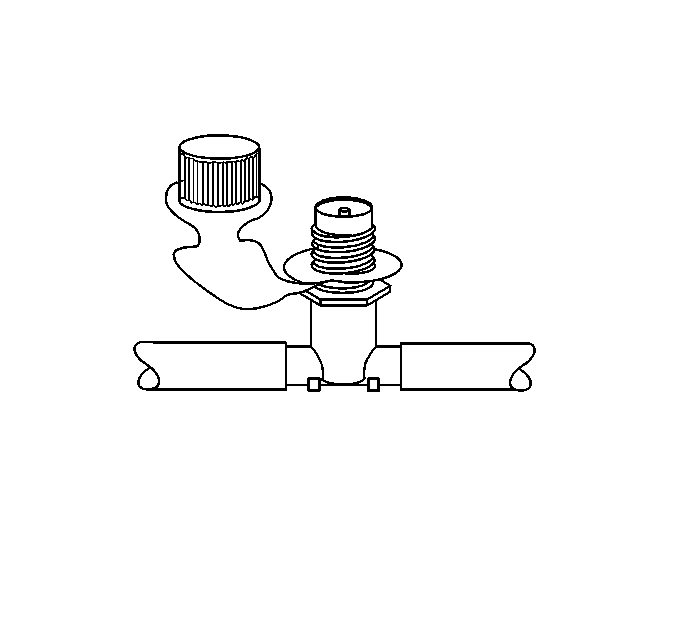
The enhanced EVAP service
port is located in the EVAP pipe in the engine compartment near the purge
solenoid. The service port is identified by a green cap. The
port contains a schrader valve and a fitting in order to allow the
connection of the J 41413
EVAP Pressure/Purge Diagnostic Station for diagnosis of the
evaporative emission system.
On-Board Refueling Vapor Recovery System (ORVR)

The on-board refueling
vapor recovery system (ORVR) is an on-board vehicle system that is designed
to recover the fuel vapors during the vehicle refueling operation.
The flow of liquid fuel down the fuel filler pipe provides a liquid
seal, which prevents the vapor from leaving the fuel filler pipe.
An EVAP pipe transports the fuel vapor to the EVAP canister for use
by the engine. Listed below are the ORVR system components with
a brief description of their operation:
| • | The EVAP canister (1)--The EVAP canister receives
refueling vapor from the fuel system, stores the vapor and releases the vapor
to the engine upon demand. |
| • | The EVAP pipes (2)--The EVAP pipes transport the fuel
vapor from the fuel tank to the EVAP canister. |
| • | The fuel filler pipe (3)--The fuel filler pipe carries
the fuel from the fuel nozzle to the fuel tank. |
| • | The check valve (4)--The check valve limits
fuel spit back from the fuel tank during the refueling operation by allowing
the fuel flow only into the fuel tank. This check valve is located
at the bottom of the fuel filler pipe. |
| • | The modular fuel sender assembly (5)--The assembly
pumps the fuel to the engine from the fuel tank. |
| • | The fill limiter vent valve (FLVV) (6)--This valve
acts as a shut-off valve. The FLVV is located on the top of the fuel tank.
This valve is not serviced separately. The FLVV has the following
functions: |
| - | The FLW controls the fuel tank fill level by closing the primary
vent from the fuel tank. |
| - | The FLW prevents the fuel from exiting the fuel tank via the EVAP
pipe to the canister. |
| - | The VLW provides fuel-spillage protection in the event of a vehicle
rollover by closing the vapor path from the tank to the EVAP canister. |
| • | The over pressure relief valve (7)--The over pressure
relief valve provides venting of excessive fuel tank pressure. The valve is
located on the top of the fuel tank next to the FLVV. This valve is not
serviced separately. |
Modes of Operation
The PCM looks at voltages from several sensors to determine how much
fuel to give the engine. The fuel is delivered under one of several conditions
called modes. The PCM controls all modes.
Starting Mode
With the ignition ON, before engaging the starter, the PCM energizes
the fuel pump relay for two seconds allowing the fuel pump to build up pressure.
The PCM first checks speed density, then switches to the mass air flow (MAF)
sensor. The PCM also uses the engine coolant temperature (ECT), throttle
position (TP), and manifold absolute pressure (MAP) sensors to determine
the proper air/fuel ratio for starting. This ranges from 1.5:1 at -36°C
(-33°F) to 14.7:1 at +94°C (+201°F) running temperature.
The PCM controls the amount of fuel delivered in the starting mode by changing
the pulse width of the injectors. This is done by pulsing the injectors for
very short times.
Clear Flood Mode
If the engine floods, clear the engine by pushing the accelerator pedal
down all the way. The PCM then pulses the injectors at an air/fuel ratio of
20:1. The PCM holds this injector rate as long as the throttle stays wide
open and the engine speed is below 300 RPM. If the throttle position
becomes less than 80 percent, the PCM returns to the starting
mode.
Run Mode
The run mode has two conditions called Open Loop and Closed Loop. When
the engine is first started, and engine speed is above a predetermined RPM,
the system begins Open Loop operation. The PCM ignores the signal from the
HO2S and calculates the air/fuel ratio based on inputs from the ECT, MAF,
MAP, and TP sensors. The system stays in Open Loop until meeting the following
conditions:
| • | Both HO2S have varying voltage output, showing that they are hot
enough to operate properly. This depends on temperature. |
| • | The ECT sensor is above a specified temperature. |
| • | A specific amount of time has elapsed after starting the engine. |
Specific values for the above conditions exist for each different engine,
and are stored in the electrically erasable programmable read only memory
(EEPROM). The system begins Closed Loop operation after reaching these values.
In Closed Loop, the PCM calculates the air/fuel ratio (injector on-time)
based on the signal from various sensors, but mainly the HO2S. This allows
the air/fuel ratio to stay very close to 14.7:1.
Acceleration Mode
When the driver pushes on the accelerator pedal, air flow into the cylinders
increases rapidly, while fuel flow tends to lag behind. To prevent possible
hesitation, the PCM increases the pulse width to the injectors to provide
extra fuel during acceleration. The PCM determines the amount of fuel required
based on throttle position, coolant temperature, manifold air pressure, mass
air flow and engine speed.
Deceleration Mode
When the driver releases the accelerator pedal, air flow into the engine
is reduced. The PCM looks at the corresponding changes in throttle position,
manifold air pressure and mass air flow. The PCM shuts OFF fuel completely
if the deceleration is very rapid, or for long periods, such as long closed
throttle coast-down. The fuel shuts OFF in order to protect the
warm-up three-way catalytic converters.
Battery Voltage Correction Mode
When battery voltage is low, the PCM compensates for the weak spark
delivered by the ignition system in the following ways:
| • | Increasing the amount of fuel delivered |
| • | Increasing the idle RPM |
| • | Increasing ignition dwell time |
Fuel Cutoff Mode
To prevent possible engine damage from over-speed, the PCM cuts off
fuel from the injectors when the engine speed is above approximately 5800
RPM. Also, see Rapid Deceleration in Deceleration Mode.
The fuel metering system consists of the following parts:
| • | The fuel supply components: |
| • | The fuel pump electrical circuit |
| • | The fuel pressure regulator |
| • | The idle air control (IAC) valve |
| • | The throttle position (TP) sensor |
System Overview
The fuel tank stores the fuel supply. An electric fuel pump, located
in the fuel tank with the fuel sender assembly, pumps the fuel through an
in-line fuel filter to the fuel rail assembly. The pump provides fuel
at a pressure greater than what is needed by the injectors. The fuel
pressure regulator, part of the fuel sender assembly, keeps the fuel
available to the injectors at a regulated pressure. A separate pipe
returns the unused fuel to the fuel tank.
Fuel Pump Electrical Circuit
When the ignition switch is in the ON position, before engaging the
starter), the PCM energizes the fuel pump relay for 2 seconds, causing
the fuel pump to pressurize the fuel system. If the PCM does not receive
ignition reference pulses with the engine cranking or running within 2 seconds,
the PCM shuts OFF the fuel pump relay, causing the fuel pump to stop.
Fuel Rail Assembly
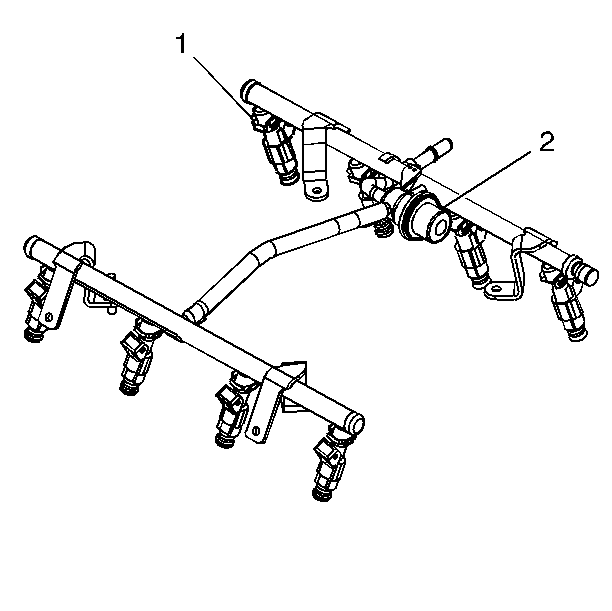
The fuel rail assembly
attaches to the engine intake manifold. The fuel rail assembly performs the
following functions:
| • | The fuel rail positions the injectors (1) in the intake
manifold. |
| • | The fuel rail distributes the fuel evenly to the injectors. |
| • | The fuel rail integrates the fuel pulse dampener (2) into
the fuel metering system. |
Fuel Injectors
The top-feed fuel injector assembly is a solenoid-operated device, controlled
by the PCM, that meters pressurized fuel to a single engine cylinder. The
PCM energizes the injector solenoid, which opens a ball valve, allowing
the fuel to flow past the ball valve, and through a recessed flow director
plate. The director plate has multiple machined holes that control the
fuel flow, generating a conical spray pattern of finely atomized fuel
at the injector tip. Fuel is directed at the intake valve, causing the
fuel to become further atomized and vaporized before entering the combustion
chamber. An injector that is stuck partly open can cause a loss of pressure
after the engine shutdown. Consequently, long cranking times would be
noticed on some engines.
Fuel Pulse Dampener

The fuel pulse dampener
attaches inside a housing on the fuel rail assembly. The fuel pulse dampener
is diaphragm-operated, with fuel pump pressure on one side and with spring
pressure on the other side. The function of the dampener is to dampen
the fuel pulsation.
Accelerator Controls
The accelerator control system is cable operated. There are no linkage
adjustments. Use the specific cable for each application.
Throttle Body Assembly
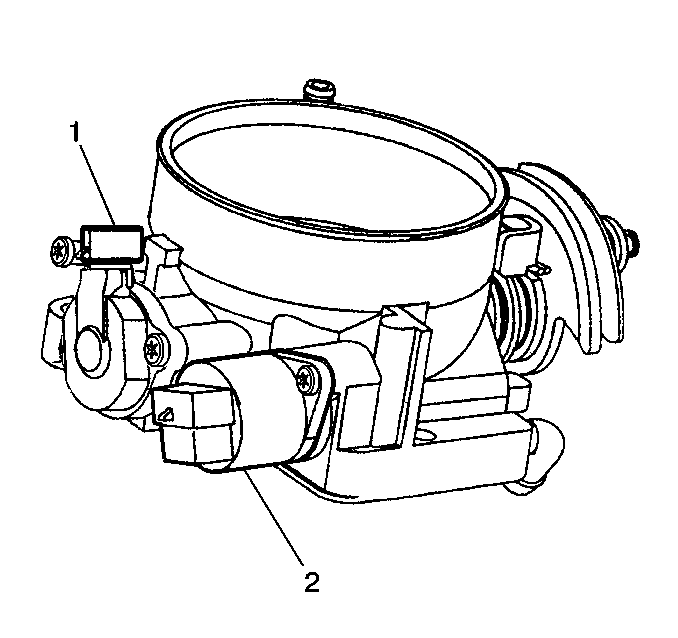
The throttle body assembly
attaches to the intake manifold. The throttle body controls the air flow into
the engine, thereby controlling the engine output. The vehicle operator
opens the throttle valve within the throttle body through the accelerator
controls. During engine idle, the throttle valves are almost closed.
A fixed air bypass orifice and the Idle Air Control (IAC) valve (2)
handle the air flow control. Engine coolant flows through the coolant
cavity on the bottom of the throttle body in order to prevent throttle
valve icing during cool weather operation. The throttle body also provides
the location for mounting the Throttle Position (TP) sensor (1).
Idle Air Control (IAC) Valve

The purpose of the IAC valve is to control the engine idle speed, while
preventing stalls due to changes in the engine load. The IAC valve (1),
mounted in the throttle body, controls the bypass air around the throttle
valve (2). By moving a conical valve known as a pintle (3),
in, towards the seat, in order to decrease the air flow, or out, away
from the seat, in order to increase the air flow, a controlled amount
of air can be bypassed. If engine speed is too low, more air is bypassed
in order to increase the RPM. If engine speed is too high, less air
is bypassed i order to decrease the RPM. The PCM moves the IAC valve in small
steps, called counts. These counts can be measured and displayed by
a scan tool, which plugs into the Data Link Connector (DLC). The PCM
calculates the proper position of the IAC valve during idle based on
the battery voltage, the coolant temperature, the engine load, and the
engine RPM. If the RPM drops below specification and the throttle valve
is closed, the PCM senses a near stall condition and calculates a new
valve position in order to prevent stalling.
| • | The engine idle speed is a function of total air flow into the
engine. The idle speed is based on the IAC valve pintle position, the crankcase
ventilation valve flow, the throttle valve opening, the bypass orifice
air flow, and the calibrated vacuum loss through the accessories. |
| • | Controlled idle speed is programmed into the PCM, which determines
the correct IAC valve pintle position in order to maintain the desired idle
speed for all engine operating conditions and loads. |
| • | The minimum idle air rate is set at the factory with a stop screw.
This setting allows enough air flow by the throttle valves to cause the IAC
valve pintle to be positioned a calibrated number of steps, or counts,
from the seat during controlled idle operation. |
| • | If the IAC valve is disconnected and reconnected with the engine
running, the idle speed may be wrong. If this occurs, reset the IAC valve
by depressing the accelerator pedal slightly. Start and run the engine
for 5 seconds, then turn the ignition OFF for 10 seconds. |
Throttle Position (TP) Sensor
The TP sensor attaches to the side of the throttle body opposite the
throttle lever. The TP sensor senses the throttle valve angle and relays that
information to the PCM. The PCM requires knowledge of throttle angle
to generate the required injector control signals, or pulses.
The short term fuel trim (FT) is a PCM erasable memory
register. The neutral value for the short term FT is 0 percent. Any
deviation from 0 percent indicates that the short term FT
is changing the injector pulse width. The amount of pulse width
change depends on how far the short term fuel trim value is from
0 percent. The short term FT is rich when the scan tool indicates
a negative number. The short FT is lean when the scan tool indicates
a number greater than 0. The short term FT changes the injector
pulse width by adding to or subtracting from the base pulse width equation.
As the PCM monitors the oxygen sensors input, the PCM constantly varies
the short term FT value. The value is updated very quickly, therefore
the short term FT only corrects for short term mixture trends. The
correction of the long term mixture trends is the function of long
term FT.
When the PCM determines that the short term FT is out of the operating
range, 1 of the following DTCs will set:
| • | DTC P0171 FT System Lean Bank 1 |
| • | DTC P0172 FT System Rich Bank 1 |
| • | DTC P0174 FT System Lean Bank 2 |
| • | DTC P0175 FT System Rich Bank 2 |
The FT is a matrix of cells arranged by RPM and MAP. Each
cell of the long term FT is a register like the short term FT. As the
engine operating conditions change, the PCM will switch from cell to
cell in order to determine what long term FT factor to use in the base
pulse width equation.
While in any given cell, the PCM also monitors the short term FT. If
the short term FT is far enough from 0 percent, the PCM will change
the long term FT value. Once the long term FT value is changed, the
PCM should force the short term FT back toward 0 percent. If the mixture
is still not correct, as judged by the PCM, the short term FT will
continue to have a large deviation from the ideal 0 percent.
In this case, the long term FT value will continue to change until the
short term FT becomes balanced. Both the short term FT and the long
term FT have limits which vary by calibration. If the mixture is off
enough so that long term FT reaches the limit of its control and still
cannot correct the condition, the short term FT would also go to its
limit of control in the same direction. If the mixture is still not
corrected by both short term FT and long term FT at their extreme values,
a FT DTC will likely result. When the PCM determines that the long
term FT is out of the operating range, the following DTCs will set:
| • | DTC P0171 FT System Lean Bank 1 |
| • | DTC P0172 FT System Rich Bank 1 |
| • | DTC P0174 FT System Lean Bank 2 |
| • | DTC P0175 FT System Rich Bank 2 |
Under the conditions of power enrichment, the PCM sets the short term
FT to 0 percent. The PCM freezes the short term FT there until the
power enrichment is no longer in effect. This is done so the Closed
Loop factor and the long term FT will not try to correct for the commanded
richness of power enrichment.











